This article has been corrected. See "Corrigendum to: Pre-ischemic treatment with ampicillin reduces neuronal damage in the mouse hippocampus and neostriatum after transient forebrain ischemia" in Volume 26 on page 227.
Abstract
Ampicillin, a β-lactam antibiotic, has been reported to induce astrocytic glutamate transporter-1 which plays a crucial role in protecting neurons against glutamate excitotoxicity. We investigated the effect of ampicillin on neuronal damage in the mouse hippocampus and neostriatum following transient global forebrain ischemia. Male C57BL/6 mice were anesthetized with halothane and subjected to bilateral occlusion of the common carotid artery for 40 min. Ampicillin was administered post-ischemically (for 3 days) and/or pre-ischemically (for 3 ~ 5 days until one day before the onset of ischemia). Pre- and post-ischemic treatment with ampicillin (50 mg/kg/day or 200 mg/kg/day) prevented ischemic neuronal death in the medial CA1 area of the hippocampus as well as the neostriatum in a dose-dependent manner. In addition, ischemic neuronal damage was reduced by pre-ischemic treatment with ampicillin (200 mg/kg/day). In summary, our results suggest that ampicillin plays a functional role as a chemical preconditioning agent that protects hippocampal neurons from ischemic insult.
REFERENCES
Anderson CM., Swanson RA. Astrocyte glutamate transport: review of properties, regulation, and physiological functions. Glia. 32:1–14. 2000.

Benveniste H. The excitotoxin hypothesis in relation to cerebral ischemia. Cerebrovasc Brain Metab Rev. 3:213–245. 1991.
Cho KO., Kim SK., Cho YJ., Sung KW., Kim SY. A simple method for predicting hippocampal neurodegeneration in a mouse model of transient global forebrain ischemia. Korean J Physiol Pharmacol. 10:167–172. 2006.
Chu K., Lee ST., Sinn DI., Ko SY., Kim EH., Kim JM., Kim SJ., Park DK., Jung KH., Song EC., Lee SK., Kim M., Roh JK. Pharmacological Induction of Ischemic Tolerance by Glutamate Transporter-1 (EAAT2) Upregulation. Stroke. 38:177–182. 2007.

English AR., Girard D., Haskell SL. Pharmacokinetics of sultamicillin in mice, rats, and dogs. Antimicrob Agents Chemother. 25:599–602. 1984.

Huber R., Kasischke K., Ludolph AC., Riepe MW. Increase of cellular hypoxic tolerance by erythromycin and other antibiotics. Neuroreport. 10:1543–1546. 1999.

Ji HF., Shen L., Zhang HY. Beta-lactam antibiotics are multipotent agents to combat neurological diseases. Biochem Biophys Res Commun. 333:661–663. 2005.
Kanra G. Experience with ampicillin/sulbactam in severe infections. J Int Med Res. 30(1 Suppl):20A–30A. 2002.

Kirino T. Delayed neuronal death in the gerbil hippocampus following ischemia. Brain Res. 239:57–69. 1982.

Lee SG., Su ZZ., Emdad L., Gupta P., Sarkar D., Borjabad A., Volsky DJ., Fisher PB. Mechanism of ceftriaxone induction of excitatory amino acid transporter-2 expression and glutamate uptake in primary human astrocytes. J Biol Chem. 283:13116–13123. 2008.

Lipski J., Wan CK., Bai JZ., Pi R., Li D., Donnelly D. Neuroprotective potential of ceftriaxone in in vitro models of stroke. Neuroscience. 146:617–629. 2007.

Lo EH., Moskowitz MA., Jacobs TP. Exciting, radical, suicidal: how brain cells die after stroke. Stroke. 36:189–192. 2005.
Lutsar I., McCracken GH., Friedland IR. Antibiotic pharmacodynamics in cerebrospinal fluid. Clin Infect Dis. 27:1117–1128. 1998.

Mordenti J., Chappell W. The use of interspecies scaling in toxicokinetics. Yacobi A, Kelly J, Batra V, editors. eds,. Toxicokinetics and new drug development. Pergamon Press;New York: p. p. 42–96. 1989.
Murakami K., Kondo T., Kawase M., Chan PH. The development of a new mouse model of global ischemia: focus on the relationships between ischemia duration, anesthesia, cerebral vasculature, and neuronal injury following global ischemia in mice. Brain Res. 780:304–310. 1998.

Ouyang YB., Voloboueva LA., Xu LJ., Giffard RG. Selective dysfunction of hippocampal CA1 astrocytes contributes to delayed neuronal damage after transient forebrain ischemia. J Neurosci. 27:4253–4260. 2007.

Paxinos G., Franklin KBJ. The mouse brain in stereotaxic coordinates. 2nd ed.Academic Press;London: 2001.
Rao VL., Dogan A., Todd KG., Bowen KK., Kim BT., Rothstein JD., Dempsey RJ. Antisense knockdown of the glial glutamate transporter GLT-1, but not the neuronal glutamate transporter EAAC1, exacerbates transient focal cerebral ischemia-induced neuronal damage in rat brain. J Neurosci. 21:1876–1883. 2001.

Rothstein JD., Patel S., Regan MR., Haenggeli C., Huang YH., Bergles DE., Jin L., Dykes Hoberg M., Vidensky S., Chung DS., Toan SV., Bruijn LI., Su ZZ., Gupta P., Fisher PB. Beta-lactam antibiotics offer neuroprotection by increasing glutamate transporter expression. Nature. 433:73–77. 2005.
Swanson RA., Ying W., Kauppinen TM. Astrocyte influences on ischemic neuronal death. Curr Mol Med. 4:193–205. 2004.

Fig. 1.
Schematic presentation of the mouse hippocampus and caudate-putamen. Each rectangle indicates the position of two brain structures that were examined in the present study. Section is from −1.70 mm from bregma in the anteroposterior plane (adapted from Paxinos & Franklin, 2001). CA1, field CA1 of the hippocampus; CA2, field CA2 of the hippocampus; CA3, field CA3 of the hippocampus; CPu, caudate-putamen; Th, thalamus; Cx, cerebral cortex.
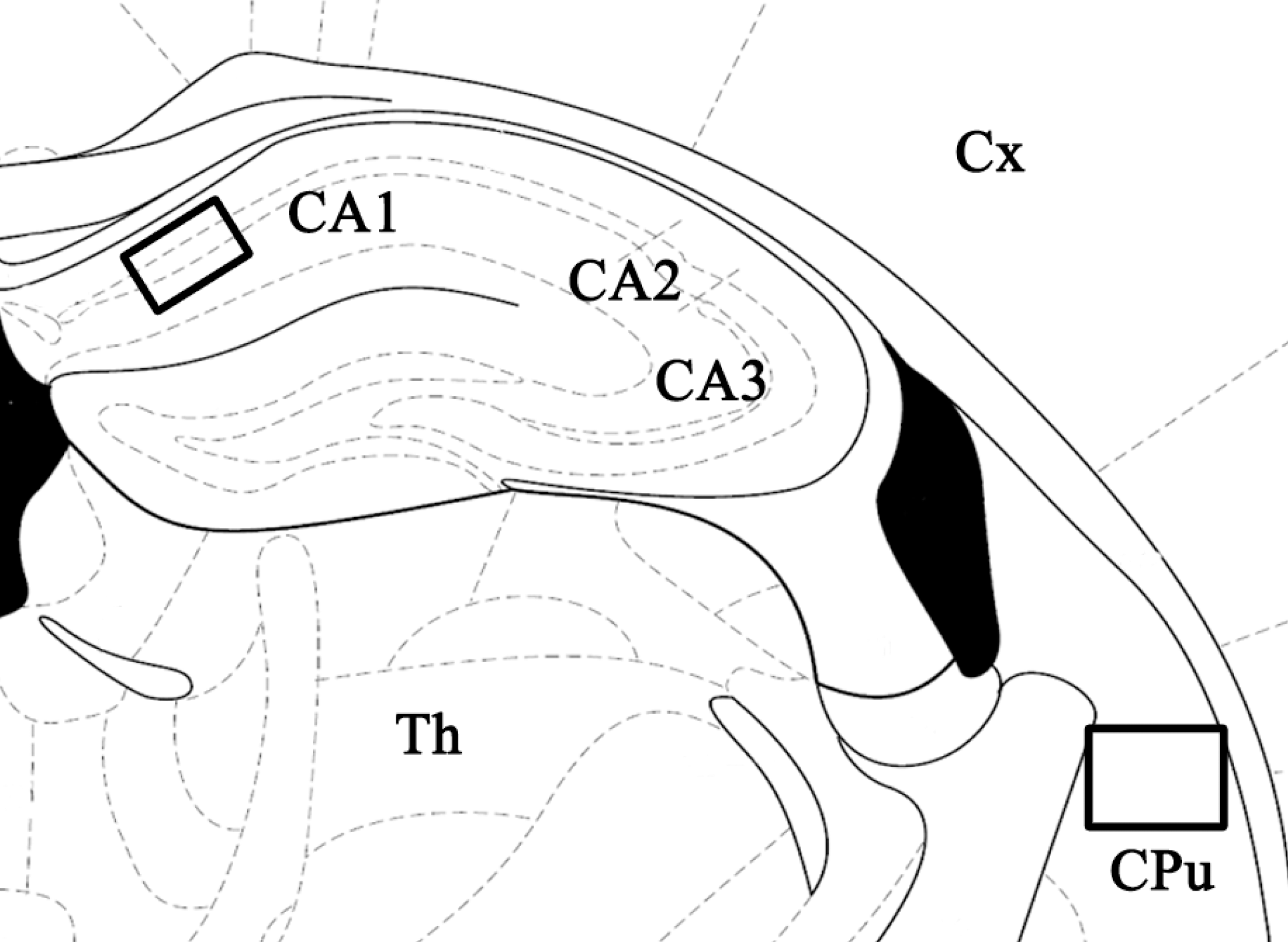
Fig. 2.
Representative photomicrographs of cresyl-violet-stained ischemic neuronal damage in the hippocampus (A, C, E, G) and the caudate-putamen (B, D, F, H) three days after transient global forebrain ischemia. sham, sham-operated group; saline, saline-treated group; Amp 50, ampicillin (50 mg/kg/day)-treated group; Amp 200, ampicillin (200 mg/kg/day)-treated group. Scale bar=20 μm (A, C, E, G), 50 μm (B, D, F, H).
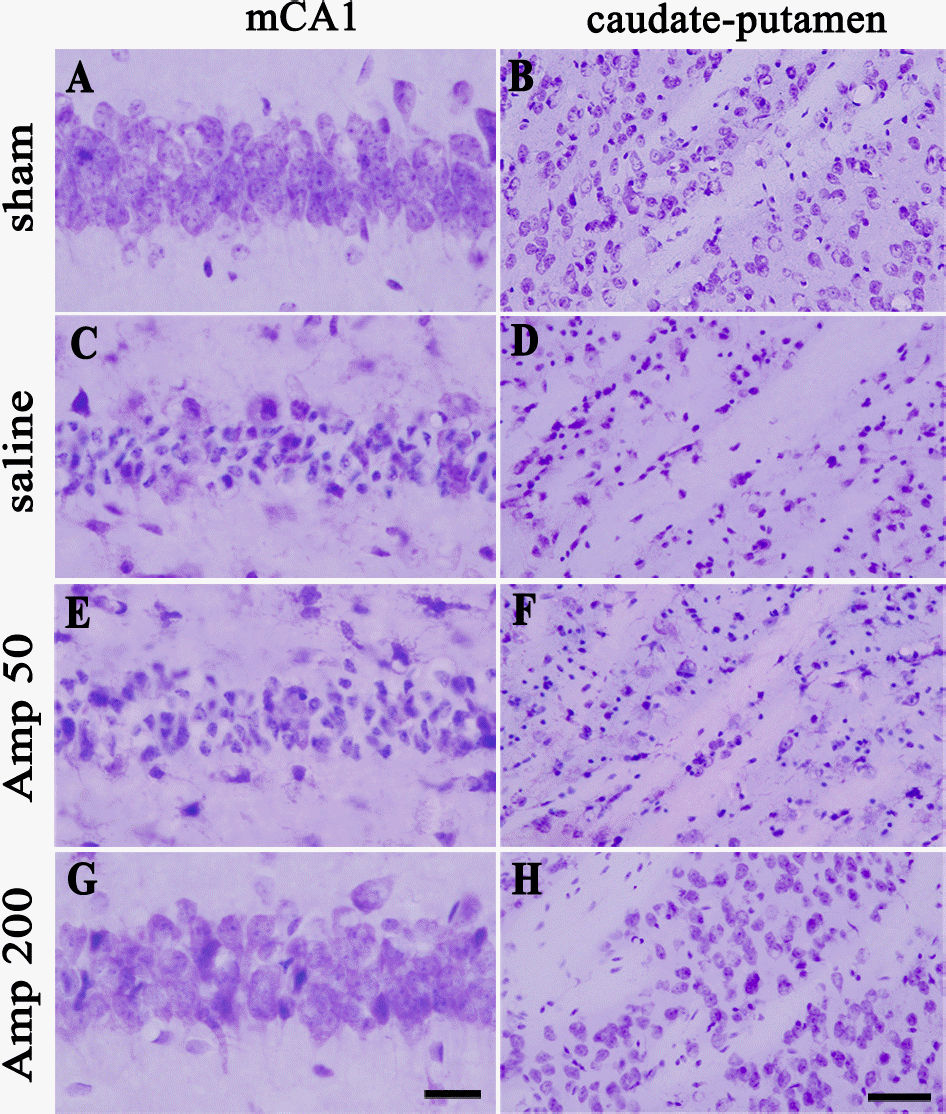
Fig. 3.
Pre- and post-ischemic treatment with ampicillin reduced the severity of ischemic neuronal damage in the medial CA1 area (mCA1) of the hippocampus and the caudate-putamen after transient global forebrain ischemia in a dose-dependent manner. Ampicillin (200 mg/kg/day)-treated group significantly reduced the severity of neuronal damage than saline-treated group or ampicillin (50 mg/kg/day)-treated group. saline, saline-treated group (n=6); Amp 50, ampicillin (50 mg/kg/day)-treated group (n=6); Amp 200, ampicillin (200 mg/kg/day)-treated group (n=6). ∗p<0.05 by χ2 test.
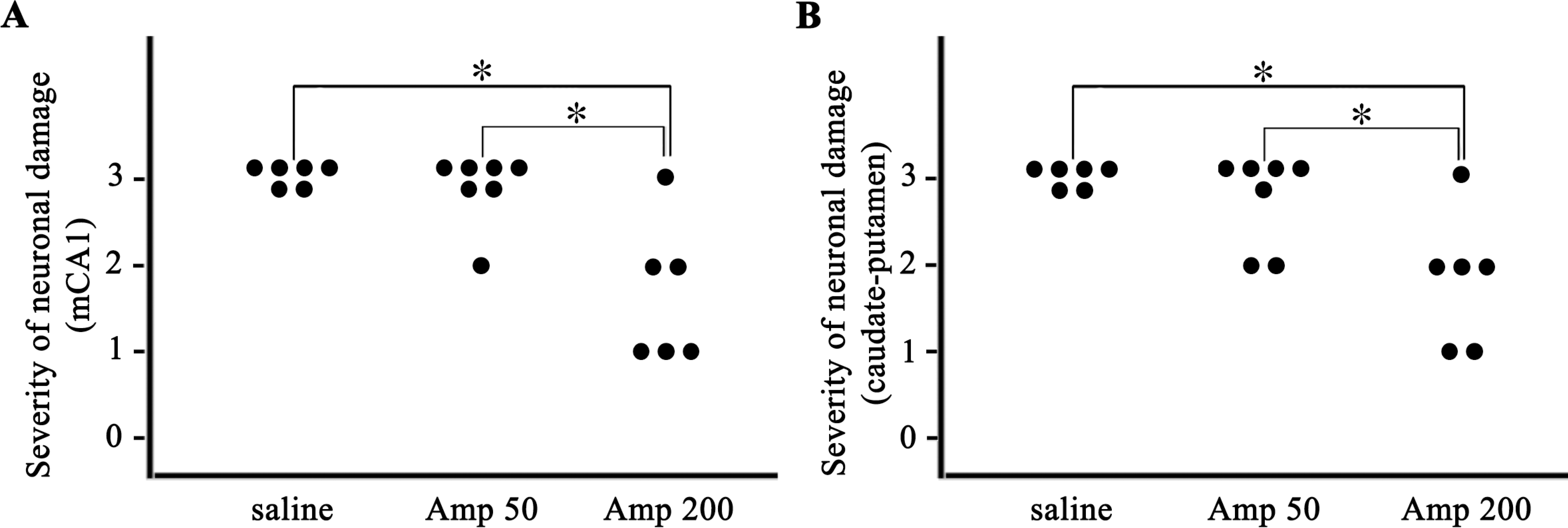
Fig. 4.
Pre-ischemic treatment with ampicillin diminishes neuronal damage in the medial CA1 area of the hippocampus and caudate-putamen three days after transient forebrain ischemia in the mouse. A: Representative photomicrographs of cresyl-violet-stained ischemic neuronal damage in the medial CA1 (mCA1) of the hippocampus and caudate-putamen. Scale bar=20 μm (a, c), 50 μm (b, d). B: Pre-ischemic treatment with ampicillin reduced the severity of ischemic neuronal damage in two brain regions. saline, saline-treated group (n=6); Amp, ampicillin (200 mg/kg/day)-treated group (n=6). ∗p<0.05 by χ2 test.
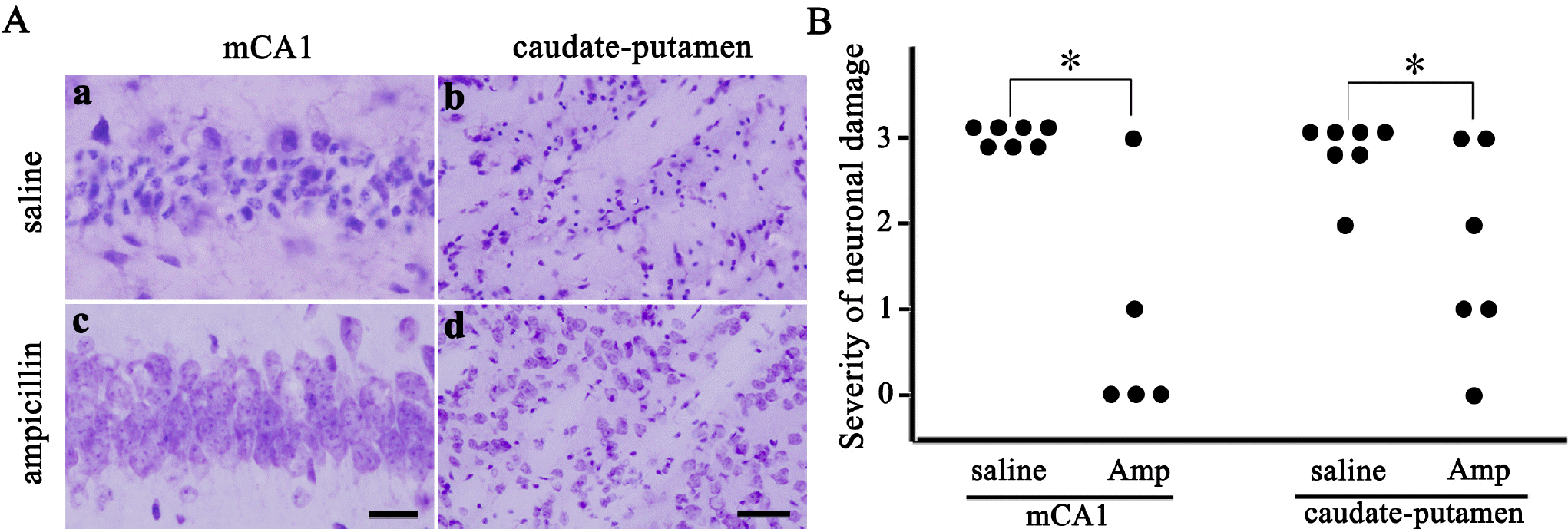
Fig. 5.
Fluoro-Jade (FJ) staining of a representative coronal brain section showing the medial CA1 area (mCA1) of the hippocampus and the caudate-putamen three days after transient forebrain ischemia. Pre-ischemic treatment with ampicillin (200 mg/kg/day) prevented ischemic neurodegeneration. Scale bar=20 μm (A, B, C, D).
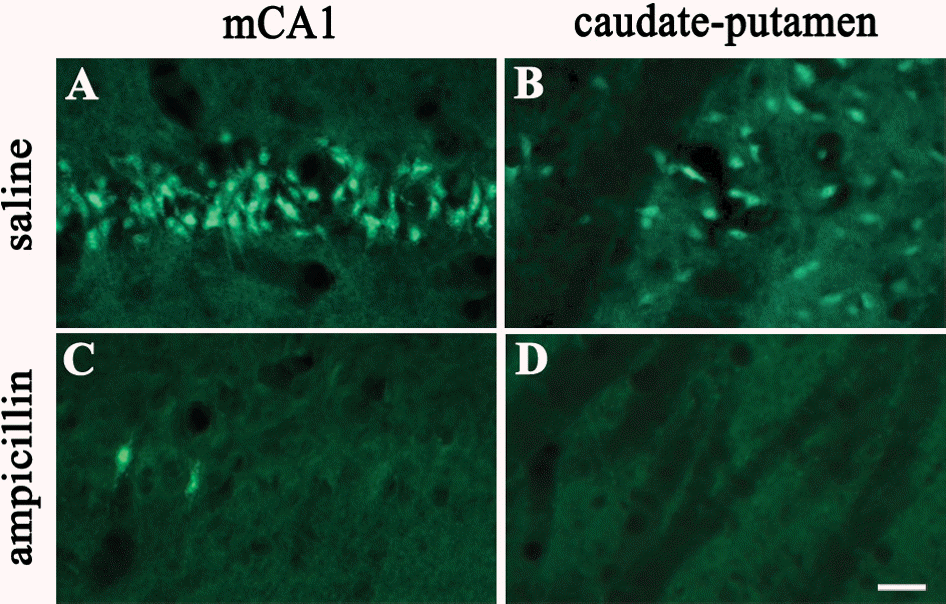




 PDF
PDF ePub
ePub Citation
Citation Print
Print


 XML Download
XML Download